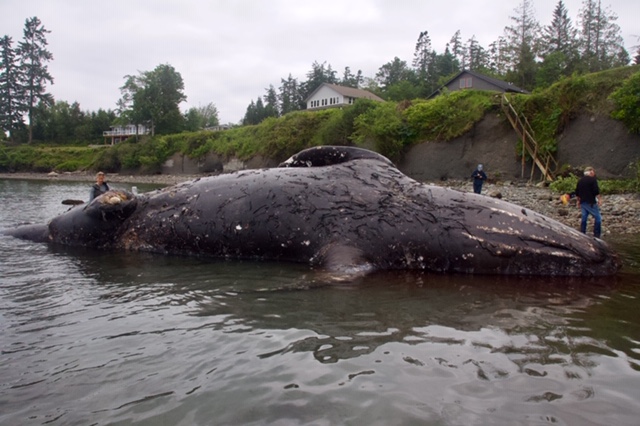Something is driving the Pacific gray whales to the beach in record numbers. As the season’s northbound migration of these majestic mammals continues, concerned scientists are trying to determine the cause of these strandings and subsequent deaths.
The gray whale:
- –Size: up to 50 feet and 40 tons (larger and heavier than a passenger bus)
- –Calves: 17 feet at birth, they consume 50 gallons of mothers milk a day
- –Migration: 10,000 miles from Baja to the Arctic and back
- –Lifespan: 50 to 70 years
As the gray whale population makes its annual migration along the West Coast from the warm lagoons of Baja to the chill waters of the Arctic, the big grays are washing ashore dead and dying in numbers not seen in 20 years.

Officials are labeling it an “Unusual Mortality Event.”
In a normal year it is not uncommon for as many as 35 whales to be stranded during an entire migration. However, so far this year, more than twice that–75–have been reported and the season is only about halfway along.
John Calambokidis, a scientist at the Cascadia Research Collective in Olympia, says we could well be on track to surpass the 1999-2000 migration death toll when 131 whales stranded on the U.S. coastline.
NOAA–the National Oceanic and Atmospheric Administration–has launched an investigation to determine the cause of what they’re calling an “Unusual Mortality Event.” No answers so far, but there are growing suspicions it has to do with the whales’ food supply.
Michael Milstein works in the Portland office of NOAA fisheries. He says most of the stranded whales they’ve studied were malnourished:
“For some reason, some of these whales did not get enough to eat last summer to last them through the rest of their year-long migration cycle down to Mexico and back again.”
Unlike their cousins the Orcas, or so-called killer whales that feed largely on fish, gray whales are filter feeders. They dive deep and strain sediments through their baleen to extract tiny shrimp-like creatures called amphipods.

David Weller is a research wildlife biologist at NOAA’s Southwest Fisheries Science Center in La Jolla. He says he and his colleagues are looking at several possible causes for the malnutrition. Among them:
- –the stranded animals may have been diseased or their food source was somehow contaminated or toxic,
- –the very size of the gray whale population–estimated at 27,000–may be too large for available food resources, or
- –there has been some change in the availability of food–either a natural cyclical pattern that happens from time to time, or, more worryingly, some fundamental environmental change like warming ocean waters or melting icecaps.
Research done during the mass strandings 20 years ago did not pinpoint a cause. It did determine that for every whale that washes ashore, 10 others are dying in the open sea and their carcasses sinking into the depths. That suggests that as many as 750 gray whales may have died so far this year – which would be more than 100% above normal in a season only half over.
To scientist Weller and others, if these current numbers are a one-time or single occurrence happening only once every several decades, they are not necessarily cause for huge alarm. They point out that the whales recovered quickly from the mass strandings 20 years ago. The gnawing worry though is the what if: what if in these times of climate extremes, the extreme numbers of the great grays washing up dead are not the exception but the new normal?



